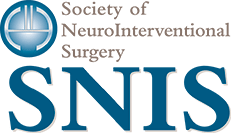Press Inquiries: Maria Enie, menie@vancomm.com
May’s Stroke Awareness Month serves as timely backdrop for new evidence showing link between stroke and coronavirus
FAIRFAX, Va. — With mounting evidence demonstrating the connection between COVID-19 and stroke, it’s more critical than ever to call 9-1-1 right away for signs of stroke, according to leading stroke surgeons who are kicking off National Stroke Awareness Month with a plea for heightened vigilance amid the pandemic.
“Despite a growing connection between COVID-19 and an increased risk of stroke, hospitals across the country continue to experience a decrease in stroke cases,” said Dr. Richard P. Klucznik, a stroke surgeon and president of the Society of NeuroInterventional Surgery. “It’s safe to assume the incidence of stroke isn’t lessening — likely just the opposite — which suggests that patients are ignoring symptoms and delaying treatment for fear of exposure to the virus.”
Under normal conditions, stroke is a leading cause of death and long-term disability. Nearly 800,000 people in the U.S. have a stroke every year, taking the lives of about 140,000 annually, and many more are left permanently disabled. Dr. Klucznik says it is likely that the number of stroke-related deaths will increase in 2020 due to the pandemic, especially if patients continue to delay treatment and reach hospitals too late.
“The connection between COVID-19 and stroke is real,” said Dr. J Mocco, a stroke surgeon at Mount Sinai Hospital, located in the epicenter of New York City’s COVID-19 crisis. “After an initial drop in stroke cases in the time leading up to surge, the number of stroke patients doubled during the COVID-19 peak and more than half were COVID-19 positive. What’s more, these patients were on average 15 years younger than typical stroke patients and among the least likely to otherwise have a stroke.”
In the case of the most serious strokes — known as an emergent large vessel occlusions (ELVO) — up to two million brain cells die each minute. The longer a patient waits before they are treated, the greater the impact the stroke will have — potentially paralyzing them for life, or worse. Patients who arrive at the hospital quickly have the best chance to survive and recover their independence following a stroke. Mocco says it’s best to use the FAST method to assess any potential stroke symptoms: Facial drooping, Arm weakness, Speech difficulties and Time to call 911.
“Patients should know that stroke units in hospitals are taking every precaution to protect our patients and our staff from COVID-19 exposure,” said Dr. Michael Levitt, a stroke surgeon with UW Medicine in Seattle. “What
remains unchanged throughout this pandemic is that we still need to play it safe when it comes to stroke and always call 9-1-1. Avoiding or delaying treatment will only lead to more deaths.”
Get Ahead of Stroke is a national public education and advocacy campaign designed to improve systems of care for stroke patients. Founded in 2016 by the Society of NeuroInterventional Surgery (SNIS), today the campaign is supported by a coalition of organizations with the goal of securing the best possible outcomes for stroke patients by driving policy change and public awareness nationwide.

